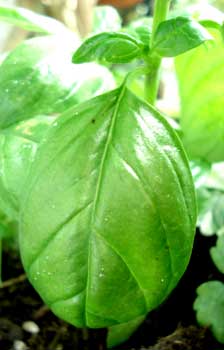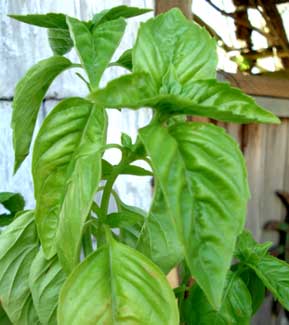
'Genovese' Italian Largeleaf
Sweet Basil
"Here's a few flowers, but 'bout midnight, more;
The herbs that have on them cold dew o' the night
Are strewings fitt'st for graves."
-Cymbeline
by William Shakespeare
Genovese largeleaf or Italian sweet basil is the variety most commonly used for commercially dried herbs, for seed-extract of volatile oils, & for classic pesto, & very easy to grow at home from potted starts or from seed.by William Shakespeare
It's a vigorous annual with spikes of white flowers, not quite as decorative as the purple basils. so more barable to keep clipping for kitchen use rather than sparing the plant for its ornamental appearance.
 It has a delightful fragrance when leaves are crushed or bruised or cut, & a splendid flavor to match whether used sparingly in green salads raw, or used in greater amounts cooked in just about anything one could wish to cook, & even used along with mint to flavor lemonaid, or as a tea.
It has a delightful fragrance when leaves are crushed or bruised or cut, & a splendid flavor to match whether used sparingly in green salads raw, or used in greater amounts cooked in just about anything one could wish to cook, & even used along with mint to flavor lemonaid, or as a tea.Delicate in cold weather, it should be started indoors until the very last possibility of temperatures below forty degrees F. It will grow swiftest in summer when temperatures are in the 70s or 80s. It wants regular watering in well-draining soil whether in containers or the open garden, in full sun.
Maximize leaf production by clipping the flower spikes before the white blossoms open. But if you do let it flower, these are just as edible as the leaves, with a slightly sweeter taste thanks to presence of nectar.
In Catholic mythology, basil is the "herb of the holy communion" also known as St. Joseph's Wort, associated with the father of Jesus. It was additionally associated with St. John the Archbiship of Braga, who supported the Templars, for whom the herb was thought to be a source of mystical visions in the Templars' purported occult experiments, rituals in common with Masonic alchemists.
It was further identified with the Hospitalers of St. John of Jerusalem, as an healing herb essential to any Hospitalers' garden; & with St. Anthony of Padua the patron saint of healing. Basil would be a typical offering to the given saint's statue, or planted in a garden dedicated to the beseeched saint. Today the Shrine of St. Anthony of Padua boasts an extensive medicinal garden in which basil figures prominently.
Further the herb was inevitably associated with St. Basil founder of Greek Orthodoxy. In his humbleness & poverty, he was said to have lived on small repasts of bread & water, except on holy holidays, when he would treat himself with herbal tea. For this reason he became the patron saint of .
The notion of basil's sacred nature may have been inherited from India, where the tulsi basil (Ocimum tenuiflorum) when depicted as a maiden Goddess Tulasi the Incomparable, a form of Laksmi as Goddess of Love, Faithfulness, & Sadness over the loss of loved ones. Tulasi was generally dressed in blue, which in Europe was the color associated with the Virgin Mary.
In Provence, basil was the Herb of Mary Mother of Sorrows, very similar to Tulasi. Because "basil" means "king," it was associated not merely with Mary, but with her son. Sweet basil was said to have first sprung from Mary's tears at the base of the Cross, or from drops of Jesus's blood, or from the tears of the women who gathered at the entrance of Christ's tomb.
But curiously just as many legends deplore it most irrationally, so that it became known among other names as the Witches' Herb. Galen of Pergamum, Pedanius Discorides the Greek physician, & Chrysippus of Soli all asserted it was deadly toxic, though it is not.
A desire to demonize basil was in part because of a mystic association with chthonic divinities. This lingered into Christian times as a belief that the herb was bad because of pagan associations.
Basil bore a direct connection to the constellation Scorpio sacred to the Virgin Huntress, & to Mars, & the meaning of "basil" is shifted to indicate the "basilisk," a venomous dragon that could kill by its gaze. The basilisk became associated in Catholic iconography with Protestant heresy, & images of St. George, or St. Michael, or other figures slaying a basilisk was meant to upraise persecution of Protestants as a holy obligation.
So the French physician Hilarius (as cited by Culpepper) alleged with no intent of hilarity that a long whiff of basil would induce a scorpion to hatch in the brain. Antonius Mizaldus with equally pokerfaced absurdity alleged that if sweet basil were laid upon a pile of dung to rot, it would transform into a nest of scorpions or asps.
Mythic symbols of this sort not only cause but control fearful things, so at the same time it was believed that basil could cure a poisonous bite or sting of hornet, scorpion, or snake.
Continue to:
'Spicy Globe' Small-leaf Basil